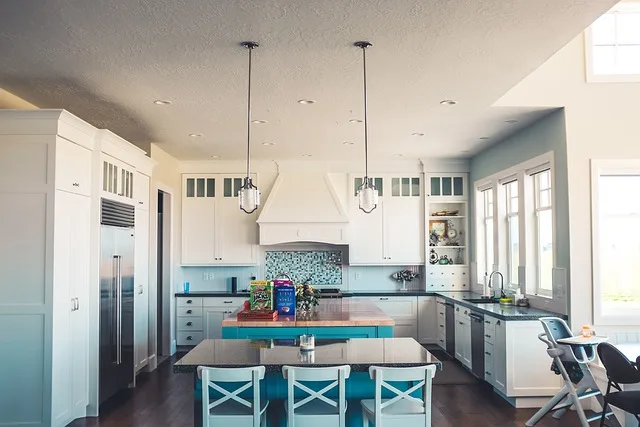First off, most kitchen cabinets are mounted using a combination of screws and brackets. Imagine your cabinets as the superheroes of your kitchen, and the screws are their trusty sidekicks, holding them in place. Typically, the installer will locate the wall studs—those sturdy wooden beams hidden behind your drywall. Why? Because attaching cabinets to these studs ensures they can bear the weight of all your pots, pans, and maybe even a few secret snack stashes!
Once the studs are located, the installer will drill pilot holes into the cabinet’s back panel. This is like giving the cabinet a little pep talk before it takes the plunge. Then, they’ll use long screws to secure the cabinet directly into the studs. It’s a straightforward process, but it’s crucial for stability. If you skip this step, you might end up with a cabinet that’s more wobbly than a toddler on roller skates!
In some cases, especially with heavier cabinets, additional support brackets might be used. Think of these brackets as the safety nets for your cabinets, providing extra reinforcement. They’re often installed at the bottom or sides of the cabinets, ensuring that even the heaviest items won’t send your cabinets crashing down.

So, next time you reach for that favorite frying pan, remember the unsung heroes behind the scenes—those screws and brackets working tirelessly to keep your kitchen organized and safe!
Behind the Scenes: The Art and Science of Attaching Kitchen Cabinets to Your Walls
First off, let’s talk about the art. Picture this: you’ve chosen the perfect cabinets, and now it’s time to make them shine. The way you position them can make or break your kitchen’s aesthetic. It’s not just about slapping them on the wall; it’s about creating a flow that feels natural. Think of it like arranging a gallery of your favorite art pieces. You want balance, symmetry, and a touch of flair.
Now, onto the science. This is where the real magic happens. You can’t just use any old screws and hope for the best. The right hardware is crucial. You need to consider the weight of the cabinets, the type of wall you’re working with, and the load they’ll bear. It’s like building a bridge; you wouldn’t want it to collapse under pressure, right? Using a stud finder to locate those hidden wooden beams in your wall is essential. They’re your best friends in this process, providing the sturdy support your cabinets need.
Nailed It! A Step-by-Step Guide to Securely Mounting Kitchen Cabinets
First things first, gather your tools. You’ll need a stud finder, level, drill, screws, and, of course, a trusty tape measure. Think of these tools as your kitchen cabinet superheroes, ready to save the day. Start by locating the studs in your wall. Why? Because those little wooden beams are your best friends when it comes to securely mounting cabinets. Trust me, you don’t want your beautiful cabinets crashing down like a bad reality show.
Once you’ve found your studs, it’s time to measure and mark where your cabinets will go. Picture this: you’re an artist, and your wall is the canvas. Use a level to ensure your marks are straight—nobody wants a lopsided cabinet that looks like it’s been through a funhouse mirror.
Now, let’s get to the fun part: drilling! Carefully drill pilot holes into the studs where you marked them. This is where your cabinets will hang, so precision is key. After that, it’s time to lift those cabinets into place. It might take a friend or two, but teamwork makes the dream work, right?
From Blueprint to Reality: How Kitchen Cabinets Find Their Place on the Wall
It all starts with a vision. Designers sketch out ideas, playing with colors, materials, and styles. Think of it like an artist preparing a canvas, where every stroke matters. Once the design is finalized, it’s time to bring those ideas to life. Skilled craftsmen take over, cutting and shaping wood with precision, almost like sculptors chiseling away at a block of marble.
But here’s where the magic happens: the cabinets are not just built; they’re engineered. Each piece is meticulously crafted to ensure durability and functionality. Imagine a puzzle where every piece fits perfectly, creating a seamless look that’s both beautiful and practical.
Now, let’s talk about installation. This is where the cabinets truly find their place on the wall. It’s not just about hanging them up; it’s about ensuring they’re level, secure, and aligned with your kitchen’s layout. Picture a tightrope walker balancing high above the ground—one misstep, and everything could come crashing down. That’s why professional installers are essential; they know the tricks of the trade to make sure your cabinets are as sturdy as they are stylish.
Once they’re up, it’s like the final touch on a masterpiece. You step back, and there they are, standing proud and ready to hold your favorite dishes, spices, and memories. It’s a transformation that turns a simple kitchen into a culinary haven, all thanks to the journey from blueprint to reality.
The Hidden Mechanics: Understanding the Fasteners That Keep Your Kitchen Cabinets Secure
Let’s dive into the hidden mechanics of these little wonders. First up, we have screws. These tiny but mighty components are the backbone of your cabinets. They’re like the glue that holds your favorite memories—think of them as the sturdy anchors that keep your shelves from sagging under the weight of your beloved cookbooks and spice jars. But not all screws are created equal! Depending on the material of your cabinets, you might need wood screws, metal screws, or even specialized cabinet screws that are designed to withstand the test of time.
Next, let’s talk about hinges. They’re the silent workhorses that allow your cabinet doors to swing open and closed with ease. Picture them as the friendly doormen of your kitchen, welcoming you to a world of culinary delights. A good hinge can make all the difference, ensuring that your doors don’t sag or misalign over time. And don’t forget about the soft-close mechanisms! They’re like the gentle touch of a friend, making sure your doors close quietly, without a loud bang.
Then there are the brackets and corner braces, the unsung champions that provide extra support. Think of them as the safety nets in a circus act, ensuring that everything stays in place, even when the kitchen gets a little chaotic. These fasteners work behind the scenes, but their impact is undeniable. So, the next time you reach for that favorite pot or pan, remember the hidden mechanics that keep your kitchen cabinets secure and ready for action!
DIY or Hire a Pro? The Best Methods for Attaching Kitchen Cabinets Explained
If you’re the DIY type, attaching cabinets can be a rewarding project. Imagine the satisfaction of stepping back and admiring your handiwork! You’ll need a few tools—think drills, levels, and maybe a friend to help hold things steady. Start by ensuring your walls are straight; a wonky wall can lead to a wonky cabinet. Use a stud finder to locate those sturdy beams behind the drywall. Trust me, you don’t want to hang your cabinets on just drywall; it’s like trying to hang a heavy painting on a piece of paper!
Now, if you’re leaning towards hiring a pro, that’s totally valid too. Professionals have the experience and know-how to get the job done right, often in a fraction of the time it would take you. They’ll know all the tricks to avoid common pitfalls, like ensuring everything is level and securely fastened. Plus, you can kick back and sip your coffee while they do the heavy lifting—sounds nice, right?
Ultimately, whether you choose to DIY or hire a pro depends on your comfort level and how much time you want to invest. If you’re excited about the challenge and have a bit of time to spare, go for it! But if you’d rather enjoy your new kitchen without the stress, calling in the experts might just be the way to go. After all, a well-attached cabinet can make all the difference in your kitchen’s functionality and style!
Wall-Mounted Wonders: Exploring Innovative Techniques for Cabinet Installation
First off, let’s talk about the beauty of hidden brackets. These little wonders are the unsung heroes of wall-mounted cabinets. They provide sturdy support while keeping the focus on the cabinet itself. It’s like having a superhero in your home—strong and reliable, yet invisible! By using these brackets, you can create a seamless look that makes your cabinets appear as if they’re defying gravity.
Next, consider the power of modular systems. These are like building blocks for adults! You can mix and match different sizes and styles to create a custom look that fits your space perfectly. Want a sleek, minimalist vibe? Go for clean lines and neutral colors. Prefer something more eclectic? Throw in a pop of color or some unique shapes. The possibilities are endless!
And let’s not forget about the importance of proper wall preparation. Think of it as laying the foundation for a house. If the wall isn’t sturdy, your cabinets won’t be either. Reinforcing the wall with plywood or using wall anchors can make all the difference. It’s like giving your cabinets a solid handshake before they take their place in your home.

So, whether you’re a DIY enthusiast or hiring a pro, these innovative techniques for cabinet installation will transform your space into a wall-mounted wonderland. Who knew that a little creativity and the right tools could lead to such stunning results?
Frequently Asked Questions
Can I Install Kitchen Cabinets on My Own?
Installing kitchen cabinets on your own is possible if you have basic carpentry skills and the right tools. It requires careful planning, precise measurements, and attention to detail. Ensure you follow manufacturer instructions and consider seeking help for heavy lifting or complex layouts to achieve a professional finish.
How Are Kitchen Cabinets Mounted to the Wall?
Kitchen cabinets are typically mounted to the wall using a combination of wall studs and brackets. First, locate the wall studs for secure anchoring. Then, use a level to ensure the cabinets are straight before attaching them with screws. Brackets may also be used for additional support, especially for heavier cabinets. Proper installation ensures stability and durability.
How Do I Ensure Cabinets Are Level When Installing?
To ensure cabinets are level during installation, start by using a level tool to check the surface where the cabinets will be placed. Adjust the cabinet legs or shims as needed to achieve a level position. Secure the cabinets together and to the wall, rechecking the level after each adjustment. This process helps prevent future issues with doors and drawers not functioning properly.
What Types of Fasteners Are Used for Wall Cabinets?
Wall cabinets typically use a variety of fasteners for secure installation, including screws, anchors, and brackets. Wood screws are commonly used to attach cabinets to wall studs, while wall anchors provide additional support when studs are not available. Brackets can be used for extra stability, especially for heavier cabinets. Selecting the right fasteners ensures durability and safety in your installation.
What Tools Do I Need to Install Kitchen Cabinets?
To install kitchen cabinets, you will need a few essential tools: a drill/driver for making holes and driving screws, a level to ensure cabinets are straight, a measuring tape for accurate dimensions, a stud finder to locate wall studs, a saw for cutting materials if necessary, and a square to check right angles. Additionally, having clamps, a hammer, and safety gear like goggles can enhance the installation process.